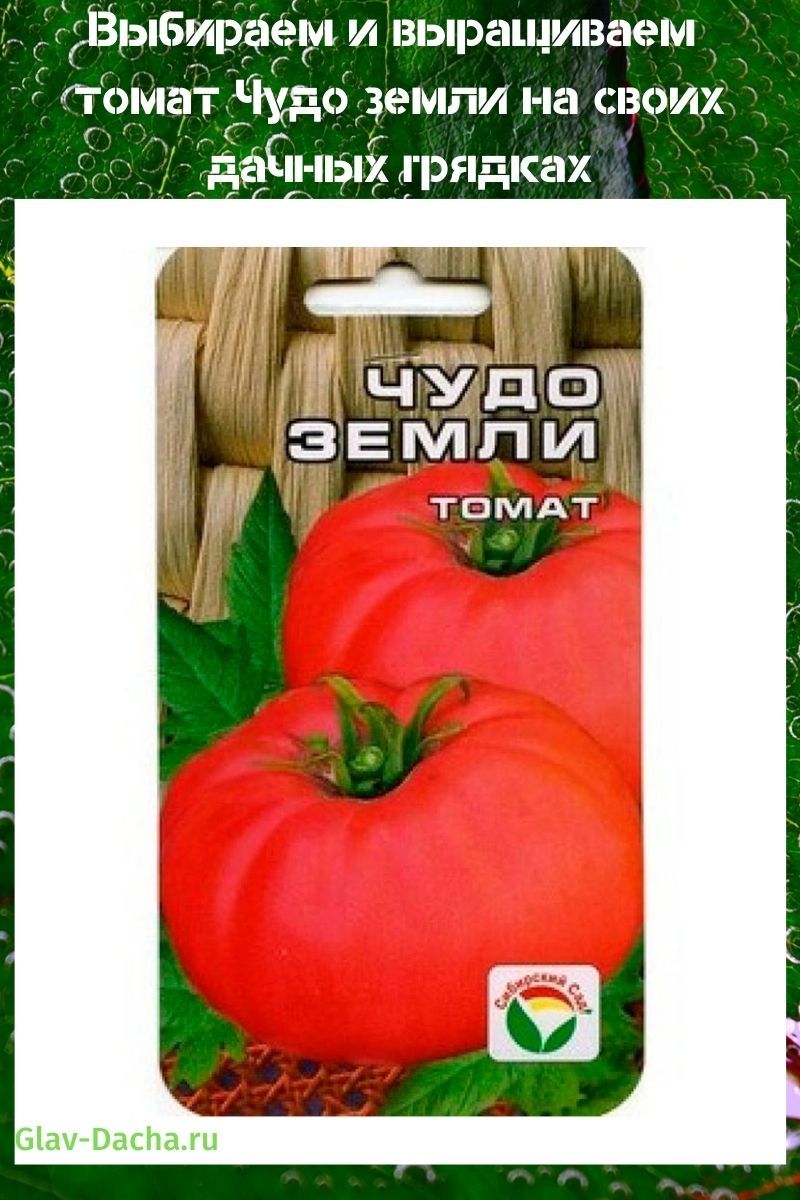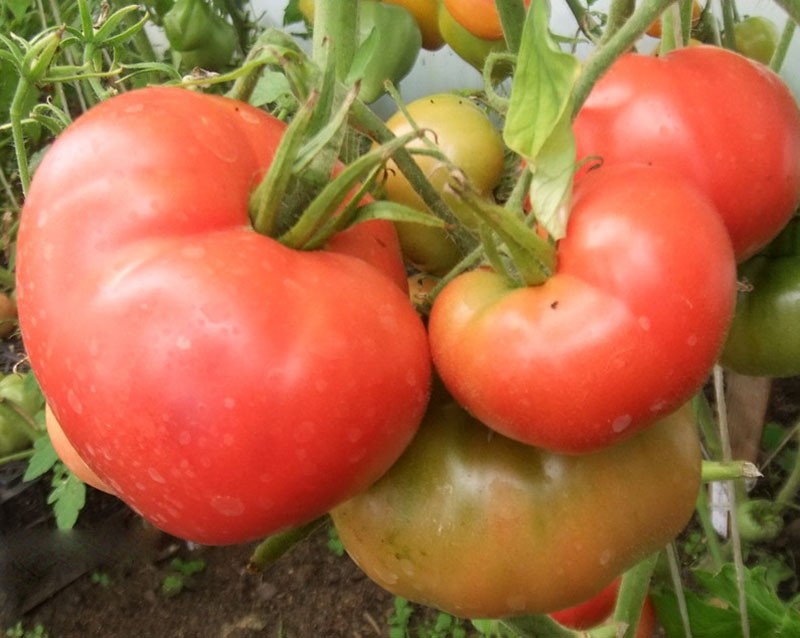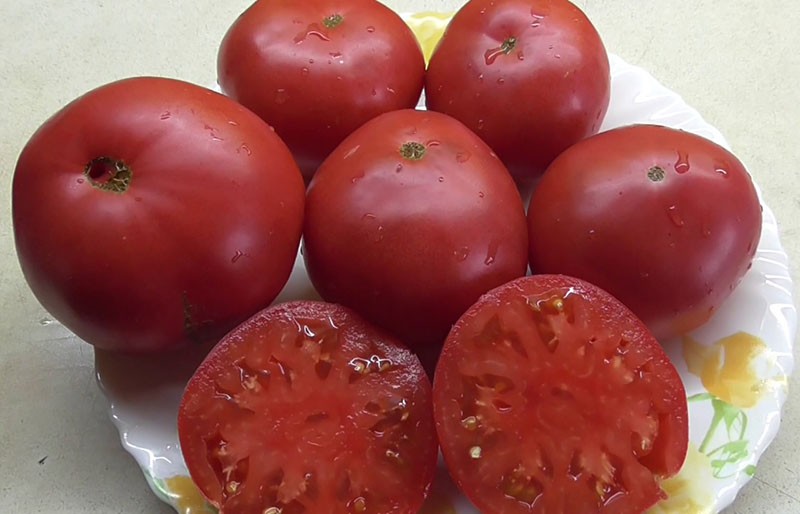Choosing and growing a tomato Miracle of the earth in our country beds
 In 2002, an unusual tomato variety appeared on the market, which was bred by a breeder-entrepreneur from Novosibirsk. Later (2006), the Miracle of the Earth tomato was officially entered into the State Register of the country. Today, the crop is grown in garden beds and greenhouses with bountiful harvests. The seeds are freely sold at specialized retail outlets. And the growing method is available even for novice gardeners.
In 2002, an unusual tomato variety appeared on the market, which was bred by a breeder-entrepreneur from Novosibirsk. Later (2006), the Miracle of the Earth tomato was officially entered into the State Register of the country. Today, the crop is grown in garden beds and greenhouses with bountiful harvests. The seeds are freely sold at specialized retail outlets. And the growing method is available even for novice gardeners.
External features of culture

Standard bushes do not form very dense stems. As a rule, they need support. Under favorable conditions, the tops grow up to 2 m in height. In order for the plant to develop successfully and bear many fruits, only 2 strong shoots are left. The fork is formed just below the first inflorescence. The rest of the stepsons are mercilessly removed.
The branches are abundantly covered with leafy dark green plates of medium size. During the flowering period, buds appear between them, from which fruits are formed. In ripe form, they weigh about 400 g. However, there are also larger specimens, reaching 1 kg.
 The fruits are covered with a thin but strong enough skin. The pulp contains up to 5% dry matter, among which there are seeds. When fully ripe, they are used to grow crops. Tomatoes have an excellent sweet and sour taste. In cooking, they are used to prepare salads, juice, pasta or all kinds of sauces and dressings.
The fruits are covered with a thin but strong enough skin. The pulp contains up to 5% dry matter, among which there are seeds. When fully ripe, they are used to grow crops. Tomatoes have an excellent sweet and sour taste. In cooking, they are used to prepare salads, juice, pasta or all kinds of sauces and dressings.
The fruits of the Miracle of the Earth tomato variety lose their properties during transportation and long-term storage.
On average, the yield of the Land Miracle tomato is approximately 15 kg per 1 m². On the territory of southern latitudes, up to 20 kg are harvested from the same site. And in cold regions, only 12 kg. The indicators are influenced by the culture's resistance to temperature extremes and some diseases. For example, the plant "bypasses" late blight, which is considered the worst enemy of tomatoes.
Tomato Wonder of the earth: the advantages and disadvantages of the variety
 Growing crops on their plots, gardeners have noticed many advantages of it.
Growing crops on their plots, gardeners have noticed many advantages of it.
Let's note just a few points:
- resistance to drought and cold;
- excellent immunity;
- high productivity;
- attractive presentation;
- refined taste;
- rich aroma;
- ripe fruits do not crack.
 The disadvantage of the variety is the removal of stepchildren when forming bushes. Due to the weighty fruits, the plant needs reliable support. Usually it is made from wooden stakes or simple structures similar to trellis.
The disadvantage of the variety is the removal of stepchildren when forming bushes. Due to the weighty fruits, the plant needs reliable support. Usually it is made from wooden stakes or simple structures similar to trellis.
Unfortunately, there are fake Wonder of the Earth tomato seeds on the market that do not match the characteristics of the variety.
Agricultural technology of cultivation
 The culture takes root wonderfully both in the open field and in the greenhouse. Planting material is purchased in specialized stores in order to obtain an authentic variety.
The culture takes root wonderfully both in the open field and in the greenhouse. Planting material is purchased in specialized stores in order to obtain an authentic variety.
Sow it in boxes 50 days before the approximate date of transferring seedlings to the garden according to the following scheme:
- seeds are soaked in warm water for several hours;
- containers are filled with fertile soil;
- moisten the upper soil ball with a sprayer;
- make shallow holes;
- sow seeds.
Then the containers are taken to a room where the temperature is maintained at about + 20 ° C. Stretch a film on top or put transparent glass. After about 10 days, shoots will appear. After the appearance of real leaf plates, the bushes dive into separate pots or containers. When the bushes get stronger, they are prepared for the changing environment.
 For 14 days, the seedlings are taken outside and kept for 30 minutes. Gradually, the time is increased to 12 hours. Seedlings of the Miracle of the Earth tomato variety, ready for the new conditions, are transferred directly to the garden bed or to the greenhouse, where they maintain the optimum temperature of + 23-25 ° C. Thanks to this microclimate, self-pollination of the culture occurs.
For 14 days, the seedlings are taken outside and kept for 30 minutes. Gradually, the time is increased to 12 hours. Seedlings of the Miracle of the Earth tomato variety, ready for the new conditions, are transferred directly to the garden bed or to the greenhouse, where they maintain the optimum temperature of + 23-25 ° C. Thanks to this microclimate, self-pollination of the culture occurs.
To get large fruits, 2-3 ovaries are left on each flowering brush.
Open ground planting rules
 The first step is to prepare the bed. The plowed soil is leveled with a rake. At a distance of 70-80 cm from each other, holes are made. As a rule, 3-4 bushes are placed on 1 m². About 1 liter of water is poured into each hole. The seedlings are laid out at an angle of 45 °. Then sprinkle with soil and compact the top layer. Next to the bushes, supports are installed, up to 2 m in height, or strong trellises are erected.
The first step is to prepare the bed. The plowed soil is leveled with a rake. At a distance of 70-80 cm from each other, holes are made. As a rule, 3-4 bushes are placed on 1 m². About 1 liter of water is poured into each hole. The seedlings are laid out at an angle of 45 °. Then sprinkle with soil and compact the top layer. Next to the bushes, supports are installed, up to 2 m in height, or strong trellises are erected.
It is desirable to tie the branches with a thick and wide rope so as not to damage the young shoots.
What care does a tomato need? Miracle of the earth
 Successful cultivation of tomatoes Miracle of the earth directly depends on timely watering and feeding. Humidification is carried out depending on weather conditions. If necessary, young seedlings are watered once a week with 3 liters of liquid under each bush. The procedure is performed after sunset or early in the morning. The next day, the dried soil in the root area is thoroughly loosened, while removing weeds.
Successful cultivation of tomatoes Miracle of the earth directly depends on timely watering and feeding. Humidification is carried out depending on weather conditions. If necessary, young seedlings are watered once a week with 3 liters of liquid under each bush. The procedure is performed after sunset or early in the morning. The next day, the dried soil in the root area is thoroughly loosened, while removing weeds.
The culture is fed with substances that contain phosphorus, nitrogen and calcium. If possible, use a solution of mullein or chicken droppings.
Throughout the season, tomatoes are fertilized 3 times:
- on the 15th day after planting in an open bed;
- during flowering;
- with the gradual ripening of the fruit.
In the first month of summer, they begin to form compact bushes. As a rule, they consist of 2 shoots. Leave the most dense and elastic specimens. The rest of the stepsons, who have reached 8 cm in height, are carefully cut off. If necessary, the procedure is repeated every 10 days in the early morning or evening.
It is advisable to remove stepchildren only until mid-July so as not to disrupt the process of tomato development.
Hilling and applying mulch
 Tall crops need a solid foundation. Therefore, the Miracle of the earth tomatoes are well spud at least 3 times. The hill is formed in the root area of the plant. If there is dry, sultry weather outside for a long time, the soil is covered with mulch. Thanks to this, moisture is retained and the growth of weeds stops.
Tall crops need a solid foundation. Therefore, the Miracle of the earth tomatoes are well spud at least 3 times. The hill is formed in the root area of the plant. If there is dry, sultry weather outside for a long time, the soil is covered with mulch. Thanks to this, moisture is retained and the growth of weeds stops.
For business use:
- straw;
- bark of coniferous trees;
- hay;
- sawdust;
- needles;
- freshly cut grass.
 In addition, mulch protects the plant from larvae May beetlewho don't like moisture. Tomatoes do not affect late blight, which significantly increases the amount of harvest. If brown spot or tobacco mosaic is found on the bushes, drastic measures are immediately applied. The infected plates are cut off, lubricating the sections with a solution of potassium permanganate.
In addition, mulch protects the plant from larvae May beetlewho don't like moisture. Tomatoes do not affect late blight, which significantly increases the amount of harvest. If brown spot or tobacco mosaic is found on the bushes, drastic measures are immediately applied. The infected plates are cut off, lubricating the sections with a solution of potassium permanganate.
For the treatment of tomatoes from tobacco mosaic use insecticides "Zaslon" or "Barrier".
Pests
 Like all vegetable crops, the Wonder of the Earth variety is sometimes infested with slugs. They are disposed of with wood ash. It is introduced into the root zone of the plant. Another worst enemy of tomatoes is the bear. Insects live in small groups in the garden. To get rid of them, the nests are watered with a "fiery" solution. It is made from water and pepper. The culture is saved from the tick by spraying the tops with soapy water. For 10 liters of water, 100 g of foaming agent is enough.In extreme cases, the bushes are treated with chemicals.
Like all vegetable crops, the Wonder of the Earth variety is sometimes infested with slugs. They are disposed of with wood ash. It is introduced into the root zone of the plant. Another worst enemy of tomatoes is the bear. Insects live in small groups in the garden. To get rid of them, the nests are watered with a "fiery" solution. It is made from water and pepper. The culture is saved from the tick by spraying the tops with soapy water. For 10 liters of water, 100 g of foaming agent is enough.In extreme cases, the bushes are treated with chemicals.
An amazing variety of tomatoes The Wonder of the Earth is gradually gaining popularity among gardeners. Unpretentiousness to natural conditions allows growing crops almost throughout the country. First, the seeds are sown in containers. The resulting seedlings are transferred to greenhouses (in the north) or to the beds. Care includes timely watering, feeding, spraying the tops. After about 3-4 months, large pink tomatoes with excellent taste will ripen in the garden.